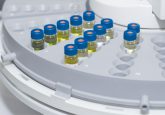Novel method to generate mirror images of drugs could allow for longer lasting medicinal effects

Researchers from the University of Toronto (ON, Canada) have discovered a method to convert molecules into their mirror images, with the hope that such a geometric change could allow drugs to bring about longer lasting effects in vivo. The team produced geometric counterparts of the drugs glycogen-like-peptide 1 (GLP1) and parathyroid hormone (PTH), utilized to treat diabetes and hypoparathyroidism respectively. The mirror image versions of these drugs were observed to exert longer lasting effects on target cells.
The team hypothesized that the mirror images of drugs could last longer in the body due to their ability to avoid being recognized and degraded by enzymes in the bloodstream and stomach. Furthermore, these peptides can often evade the immune system, which often targets natural peptides as foreign invaders, thus limiting drug efficacy, explained lead author Philip Kim (University of Toronto).
Virtually all amino acids occur in a single geometric form, with the atoms arranged to make the peptide appear left-handed, however, if the inverse orientation is utilized such a molecule would still be able to bind target receptors in the same way.
Researchers used a database containing structural information of 3 million peptides and created an algorithm to convert the left-handed forms into right-handed forms. They then searched this new library for the closest matches to GLP1 and PTH, termed D-GLP1 and D-PTH, which when trialed, were demonstrated to provoke similar responses to natural counterparts with longer lasting effects.
The findings open doors to the development of novel forms of existing drugs, which could drastically change the way patients take their medications. Kim concluded: “We are now investigating whether the D-PTH could be orally delivered because it is avoiding breakdown in the stomach. For frequently dosed medication, this is of great interest, as taking a pill is much easier than having an injection. This could lead to many more peptide drugs being taken as pills.”
Sources: Garton M, Nim S, Stone T, Wang K, Deber C and Kim P. Method to generate highly stable D-amino acid analogs of bioactive helical peptides using a mirror image of the entire PDB. PNAS. doi:10.1073/pnas.1711837115 (2018)(Epub ahead of print); phys.org/news/2018-01-glass-mirror-image-molecules-medicines.html






